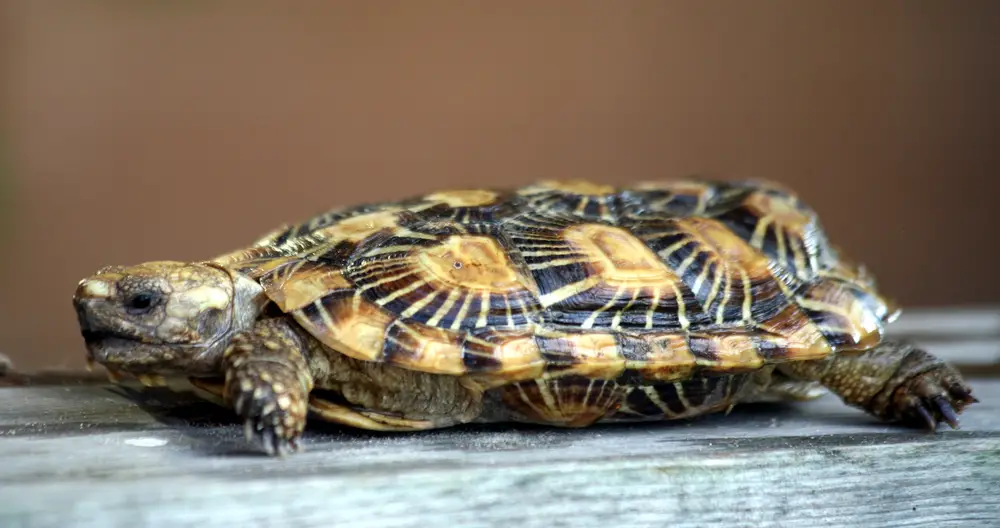With pancake tortoises becoming more popular as pets, many people are interested in learning how to provide their pet tortoises with the best, most loving environment possible. One familiar question potential pancake tortoise owners ask is, do pancake tortoises like to be handled?
Pancake tortoises, like all chelonians, don’t like to be handled. In the wild, there’s little to no chance for a tortoise to experience being picked up, so this type of interaction can stress it out. As a result, it’s best not to pick up a pancake tortoise unless necessary.
If you want to learn more about why pancake tortoises don’t like to be handled, when you can take them, and how to do it properly, read on!
Do Pancake Tortoises Like to Be Handled?
Even though handling doesn’t have any adverse effects on a pancake tortoise’s health, pancake tortoises don’t like to be handled most of, if not all, the time.
It’s not personal, but tortoises and turtles aren’t naturally accustomed to being handled. As a result, being picked up from the ground and having their feet suspended in the air is a strange and unsettling sensation for them.
Another reason why pancake tortoises may not enjoy being handled is their soft shells. Pancake tortoises are among the tortoise species with naturally more delicate surfaces.
Because these shells aren’t impervious to feeling, your pancake tortoise will be able to feel the slightest touch. So no matter how gentle you are, your tortoise may feel discomfort from the sensation of your fingertips on its shell.
That said, in some cases, one of the ways pancake tortoises show affection to their caretakers is by tolerating handling.
Still, a pancake tortoise may not enjoy it every time, so it’s better to engage in other interactions to show your pet affection.
When Can You Handle Pancake Tortoises?
Now that you know why pancake tortoises don’t like to be handled, it’s crucial to keep running at a minimum. Even better, it would help if you only took your pancake tortoise in emergencies.
For example, if you usually let your tortoise roam around, it may become trapped between or behind furniture. In this case, you’ll have to handle your tortoise to get it out.
Another situation where you may need to handle your pancake tortoise is to check the underside of its shell.
In such cases, you must ensure you don’t stress your pet. So, put your pancake tortoise back down if it displays any of the following behaviors:
- Hissing
- Scratching
- Kicking
- Withdrawing into its shell
- Trying to bite
- Emptying their bladder and cloaca
However, if your pancake tortoise doesn’t react negatively to being handled, you can lift it occasionally. Make sure you don’t handle it more than once daily and only for a few minutes.
Ultimately, it’s best to approach your pancake tortoise on its terms. There are also more effective ways to interact with your tortoise, such as hand-feeding it or gently massaging its head and neck.
Tortoises, in general, respond well to such interactions and, in turn, may show you affection by following you around and watching you as you move around.
How to Handle Pancake Tortoises
How you lift a pancake tortoise depends on its size.
Baby pancake tortoises are typically about 1–2 inches long. You can gently lift one with your fingertips at 3 and 9 o’clock positions and place it on your palm. Just make sure it doesn’t scramble off your hand.
When pancake tortoises mature, they can grow about 6–7 inches long. When handling a pancake tortoise of this size, place one hand on each side of the shell, between the forelimbs and hindlimbs.
Tips on Handling Pancake Tortoises
While handling pancake tortoises is pretty simple, there are some essential tips to keep in mind:
- Wash your hands before and after to avoid spreading germs to yourself or the tortoise.
- Handle tortoises with the utmost care, especially baby tortoises.
- Make sure to support its body firmly.
- Take care not to scratch or injure its shell to prevent infections like shell rot.
- Never flip your tortoise over to avoid stressing it out.
- Don’t handle your tortoise any more than necessary.
- Most importantly, never drop your tortoise.
FAQ
Do pancake tortoises like having their shells stroked?
Pancake tortoises enjoy having their shells stroked in a proper environment. However, just as some people want to hug while others don’t, some pancake tortoises may not enjoy touching their shells.
Do pancake tortoises like being cuddled?
Pancake tortoises, like all tortoise species, aren’t cuddly creatures. So, trying to cuddle them frequently can easily stress them out, weakening their immune system.
Your pancake tortoise can sense your affection when you talk to it, give it its favorite food, provide a good environment, and occasionally stroke its shell or gently rub its neck if it likes it.
How do I know if my pancake tortoise is happy?
You can tell that your pancake tortoise is happy if it responds well to petting. A cheerful pancake tortoise will also show curiosity and excitement about its surroundings and have a healthy appetite.
Other visible signs that your pancake tortoise is content to include dry and wrinkly skin and a strong shell.
Conclusion
Pancake tortoises are super adorable, so it may be hard to resist the temptation to pick them up. However, responsible pet owners will ask a crucial question first: do pancake tortoises like to be handled?
The short and simple answer is that they don’t like being handled or picked up often. Pancake tortoises, like all turtles and tortoises, aren’t used to being handled in nature. As a result, being picked up is an unfamiliar sensation for them, which can be stressful.
That’s why it’s best to show your pancake tortoise affection and interact with it by talking to it, hand-feeding it, and giving it gentle massages. Handling, on the other hand, should be limited to emergencies.




